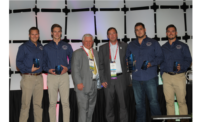IRE 2024: Roofing Alliance
U-F Gators Chomp for 'Pole Position' at 2024 Roofing Alliance Student Competition
Tenth annual competition also had a new ‘first’: two teams tied for third place

The Las Vegas Grand Prix paddock building is 1,000 feet long, 100 feet wide, three stories tall, and the only permanent structure in Grand Prix Plaza. Five teams of college students presented their plans on how to roof it and at what price during the Roofing Alliance’s 10th annual Student Competition.
— Image courtesy of Builder Developer News
It was just after 8 a.m. on Day Two of the 2024 International Roofing Expo in Las Vegas as a rite of passage commenced; muffled rumblings receded into the background as 2023-24 Roofing Alliance President Greg Bloom took to a dais to kick off the nonprofit's annual Student Competition.
Celebrating its 10th year of the event, Bloom welcomed the crowd, which was a mix of industry notables — including Michelle Boykin of Rackley Roofing in Tennessee — parents, well-wishers, and others who came to see the finalist teams presented their oral presentations, then field questions from the judges.
 “As we celebrate the competition’s 10th anniversary, our mission has remained steadfast … to promote careers in roofing management by exposing students to the roofing world in which we all live,” Bloom said, warming up the crowd as only he could.
“As we celebrate the competition’s 10th anniversary, our mission has remained steadfast … to promote careers in roofing management by exposing students to the roofing world in which we all live,” Bloom said, warming up the crowd as only he could.
Thanking a litany of people whose fingerprints are included in the success of the Student Competition, first held in 2014, Bloom praised the Roofing Alliance staff, the mentors who advised each team, the judges, many of whom have been empaneled since its inaugural and, of course, the students.
The object of attention this year was Las Vegas’ new Formula One paddock building, which began construction in 2022 and was completed for last fall’s first Las Vegas Grand Prix.
The complex, officially christened “Grand Prix Plaza” in January, is anchored by the 300,000-square-foot paddock building located on the northeast corner of Harmon Avenue and Koval Lane. This was the subject of each team’s submitted bid, prepped to replicate actual requests for proposal responses.
Winnowed down from multiple submissions, this year’s five competing teams hailed from the heartland, like Bradley University in Peoria, Ill.; the south, including Texas A&M University, University of Florida and Auburn University in Alabama; and the Rockies, with Colorado State University.
Each team had roughly 15 minutes to present their bids, focusing on overall project management, safety, quality control and assurance, and execution and cost. After presenting, team members fielded judges’ questions for an additional 10 minutes.
A distinguishing difference between this year’s competitors was just how much each team leaned into safety, even more than the 2023 competition in Dallas, focusing on heat exposure, fall protection and employment of high-tech devices to ensure worker safety.
The Bradley University team proffered to outfit each worker with a biometric sensor worn on the bicep that provides real-time data to a safety coordinator and could be monitored on a laptop, tablet, or phone in the field.
“This biometric meter measures the core body temperature and heart rate of every single worker, so if [a roofer’s] numbers are abnormal, they can be pulled into a hydration station or brought to the trailer to ensure they don’t fall,” explained senior Tyler Pilon, whose role in the group was focusing on safety.
Other schools offered similar tech novelties as well as more traditional fall protection systems. Judges John Yuko and Bob Pringle offered that it reflected a real-world shift when asked about the emphasis on safety and how that topic has evolved over the last several years.
“Safety has become a very big priority and is being pressed by the industry, which is driving the way construction management schools emphasize it,” Yuko, president of GSM Roofing of Pennsylvania, said. “It’s too important not to be constantly emphasized.”
Pringle, vice president and principal of Evans Roofing in Elmira, N.Y., agreed, drawing a direct line from the worksite to the classroom regarding how many construction management programs take their cues on what to highlight.
“Nobody wants to see one of their men or women injured —or worse — and, particularly in large-scale commercial operations, safety has to be a core [tenet],” Pringle said. “We have definitely seen safety take a front spot as the competition has evolved.”
Each team had their strengths, but as in every competition, there can be only one winner. In the end, the team from the University of Florida took pole position, collecting a $5,000 L.B. Conway scholarship award for the school.
Fun Fact: U-F's industry mentor this year was Caleb Stauss of Big D Roofing Services in Ocala, Fla. Stauss is both an alumnus of U-F and was on the Student Competition winning team in 2016 during the competition's second year at IRE, held then in Orlando, Fla.
 Second place was won by Colorado State, which earned its school a $2,500 Fred Good scholarship. And, in a first for the competition, there was a tie for third place this year, with Auburn and Bradley each snagging a $1,000 scholarship for their respective schools.
Second place was won by Colorado State, which earned its school a $2,500 Fred Good scholarship. And, in a first for the competition, there was a tie for third place this year, with Auburn and Bradley each snagging a $1,000 scholarship for their respective schools.
The other two Student Competition awards given during the National Roofing Contractors Association’s annual awards dinner later that evening were for individual presenters Nick Hanson of U-F and John Falavolito of Texas A&M, taking the No. 1 and 2 spots, respectively; Hanson earned himself a $300 American Express gift card, and Falavolito received a $200 American Express gift card.
Before knowing his school took first prize or that he would be named best presenter, Hanson, a senior and Gainesville, Fla. native who filled his team’s superintendent role, talked about where he saw himself after graduation.
“I’ll be working for the Weitz Company down in Florida as a project engineer,“ he said when asked if he saw himself as a site superintendent. “I spend a lot of time in the field with that role also, and so I think I’m comfortable [in multiple roles].”
Looking for a reprint of this article?
From high-res PDFs to custom plaques, order your copy today!







